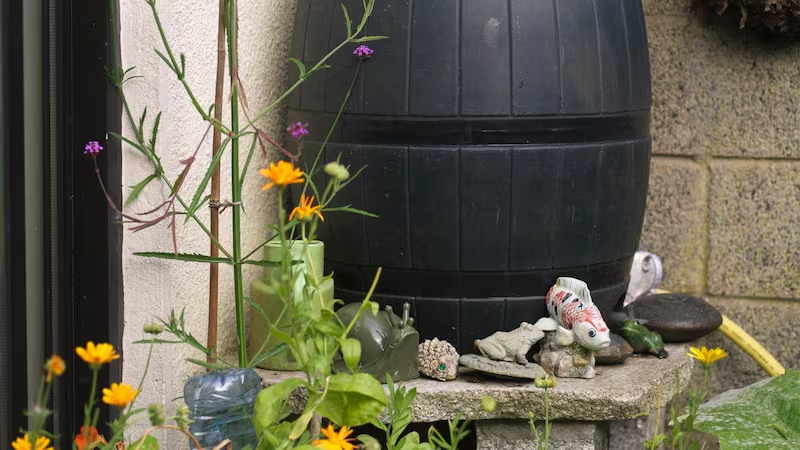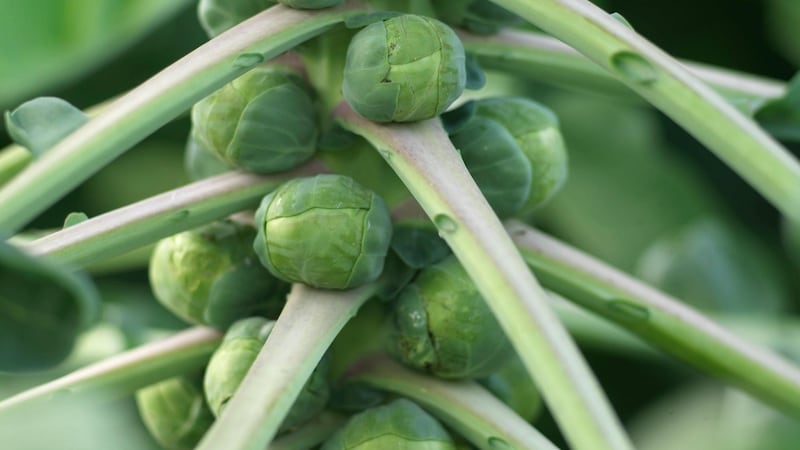What a year it’s been for gardeners. We’ve had drought. Hurricanes. Furious storms. Icy blizzards. A winter so long and arctic it exposed the fragility of the food-chain, followed by a spring so late and brief it was a challenge to get crops in the ground. And then, after all that, a summer so hot and dry that plants struggled to survive. Climate change has roared its way into our lives like an angry tempest, violently disrupting the established patterns of an Irish growing year.
Is this the new normal? Supercomputers used by scientists and meteorologists to model future climatic ‘norms’ on this little island of ours predict dramatically drier, hotter springs and summers as well as milder, wetter autumns and winters. Frost days may decrease by as much as 62 per cent and the growing season extend by as much as 40 days a year.
Those same computers also predict more extreme rainfall events, more extreme storm activity and a dramatic increase in the number of extended dry periods in summer by as much as 40 per cent, especially along the east coast. The consequences for the plant kingdom as well as the creatures that depend upon it (ourselves included) are on a scale so vast, far-reaching and complex that it’s difficult to comprehend. But what is abundantly clear is that we need to start future-proofing our gardens to cope with the meteorological extremes predicted.
How? Think of it as a myriad of mini-solutions, each one akin to a piece of the jigsaw. One way – one of the best ways – to make a difference is by swapping garden paving/ hard surfacing for plants. This simple planet-friendly adjustment will help to reduce the problem of flash-flooding caused by extreme rainfall, filter air pollution, modify those predicted extremes of temperature, protect soil health and structure, reduce the threat of subsidence associated with prolonged drought, allow environmental pollutants including oil and poisonous metals to be naturally filtered through the ground and provide important habitats for vulnerable wildlife. But it’s important to choose a mix of vigorous, disease-resistant woody, perennial and bulbous flowering species best suited to your garden’s soil and microclimate and with a proven ability to tolerate less-than-ideal growing conditions.
In particular, find room for at least one tree. Not only will its root system help to drink up excess winter rainfall, its leafy canopy provide clean air and a home for garden wildlife and its ever-changing beauty bring you endless joy, but it will also play a vital role in the fight against climate change by taking in CO2 from the air and storing it as carbon.
Environmental cost
Of course, most gardens need some sort of area of hard surfacing, whether it’s a patio, paths or a place to park the car. But for the reasons mentioned above, try to keep these to a minimum, especially the use of traditional, non-permeable materials such as conventional tarmac, concrete and stone. All come at an environmental cost and contribute greatly to the problem of ‘urban run-off’ increasingly burdening our towns’ and cities’ already-overloaded drainage systems and eroding and polluting the country’s waterways.
Where you do need to use paving, try to prioritise the use of pervious, porous or permeable materials such as ornamental pebble, hoggin (a compactable mix of clay, gravel and sand or granite dust) or one of the better-quality, modern paving products specifically designed for this purpose. The latter can be made of fired clay, concrete or stone, but are formulated in a variety of ways that either allow rainwater to easily percolate through them (classed as pervious or porous) or into the narrow joints between them (permeable).
Well-known manufacturers include Bradstone (bradstone.ie), Tobermore (tobermore.co.uk) while Belgian firm Vande Moortel produces a handsome range of porous, handmade clay pavers (vandermoortel-bricksandpavers.com). Other innovative, modern grid-like paving products made from concrete or recycled plastic allow gardeners to create ultra-durable lawns so hard-wearing they're even suitable for use as driveways and parking spaces (see geo-coastal.ie ).
Green or 'living' roofs, where traditional roofing materials are replaced with a layer of living plants grown in a shallow, lightweight layer of soil/ sand on top of a waterproof membrane, are another excellent way to help prevent the increasing problem of flash-flooding while providing a decorative and valuable mini- habitat for beneficial insects. Like permeable/porous/pervious paving, these form part of the nature-friendly, sustainable urban drainage systems (SuDS) being implemented around the world to help combat the effects of climate change (landtechsoils.ie).

Yet another way for us to future-proof our gardens is by the simple act of harvesting/ storing rainwater in rain-barrels. Connected by pipes/ hose, these can be fed from your house gutters/ rainwater goods, placed at intervals throughout your garden (because no one wants to spend their summer lugging around heavy watering cans), and designed so that the final barrel’s overflow feeds into a garden pond or artificial mini-wetland – an ingenious, environmentally-friendly design that I’ve seen being used in several town gardens.
Harmful chemicals
If you’re a lover of traditional, tightly-mown, weed-free, emerald-green lawns, the bad news is that these also contribute significantly to the problem of climate change, depending as they typically do on the regular use of artificial fertilisers, weed-killers and petrol-driven lawnmowers. So ditch the environmentally harmful chemicals and leave any freshly cut-grass on your lawn after mowing to act as a natural, organic, nutritious mulch.
If it’s only a small lawn, consider replacing that fuel-guzzling lawnmower with a push-mower (for example, Fiskar’s StaySharp Max Reel mower) or an electric model. With large, high-maintenance lawns, another environmentally-friendly solution is to reduce its size by turning sections of it into a nature-friendly, low-maintenance, traditional wildflower meadow or mini-woodland.
The most planet-friendly way to future-proof your garden is by protecting and nourishing its soil
All these suggestions aside, the most planet-friendly way to future-proof your garden is by protecting and nourishing its soil. Increasingly debased and diminished by pollution, urbanisation and the effects of climate change, the world’s soils naturally filter and store rainwater while also forming one of its largest reservoirs of terrestrial carbon.
Put simply, the healthier and more resilient the soil in your garden, the more capable it is of efficiently counteracting the effects of winter flooding and summer droughts and of supporting healthy, happy plants. So dig/walk on it as little as possible (see dunmorecountryschool.ie and charlesdowding.co.uk for advice on no-dig gardening methods), don't use nasty herbicides, pesticides and fungicides that will slowly but surely poison it, and try not to leave it nakedly exposed to the elements for any length of time.
Avoid adding peat-based products to it (yet another environmental no-no that contributes to the challenge of climate change) but do regularly replenish it with protective, nourishing mulches of homemade garden compost, sprinkles of powdered seaweed and well-rotted manure. Not only will you get to enjoy the many benefits this brings, but so will future generations.
This week in the garden . . .
Mid-winter is a good time to cut away the old foliage of hellebores to help prevent foliar diseases such as leaf blackspot spreading to the next generation of freshly emerging leaves. Bag and bin the pruned foliage rather than placing it in the compost bin where spores can survive to re-infect plants if the compost heap doesn’t reach a sufficiently high temperature. After pruning, finish off with a shallow mulch of garden compost or very well-rotted manure.
Take advantage of any mild, still days to ventilate glasshouses and polytunnels by throwing open doors and vents, but make sure to close them again in the evening. As a rule, crops/ plants grown under cover should only be watered sparingly at this time of year and always in the morning to minimise the spread of disease. For the same reason, avoid overhead watering and instead try to water directly into the soil around the roots of each plant, while avoiding wetting the foliage.

Many kitchen gardeners cover brassica crops such as winter kale, cabbage and Brussels sprouts to protect them from being eaten by hungry pigeons. But it’s really important to ensure the netting is sufficiently well-secured that garden birds or cats can’t slip through a gap and then get trapped in it. For the same reason, it’s a good idea to regularly check netted crops regularly at this time of year.
Dates for your diary
The Garden and Landscape Designers Association (GLDA) has launched 'Sustainable Garden Design Challenge', its 2019 student and graduate garden design competition. Open to any student or recent graduate (2016/2017) of an accredited garden design, landscape architecture, horticulture-related course or landscape skills training course on the island of Ireland, the design brief is to design a front and side garden for a semi-detached house that complies with recent guidelines related to SuDS (sustainable drainage systems) applicable to all housing developments in the Greater Dublin Area. Deadline for completed applications is Saturday, 19th January, see glda.ie or email studentawards@glda to find out more.


















